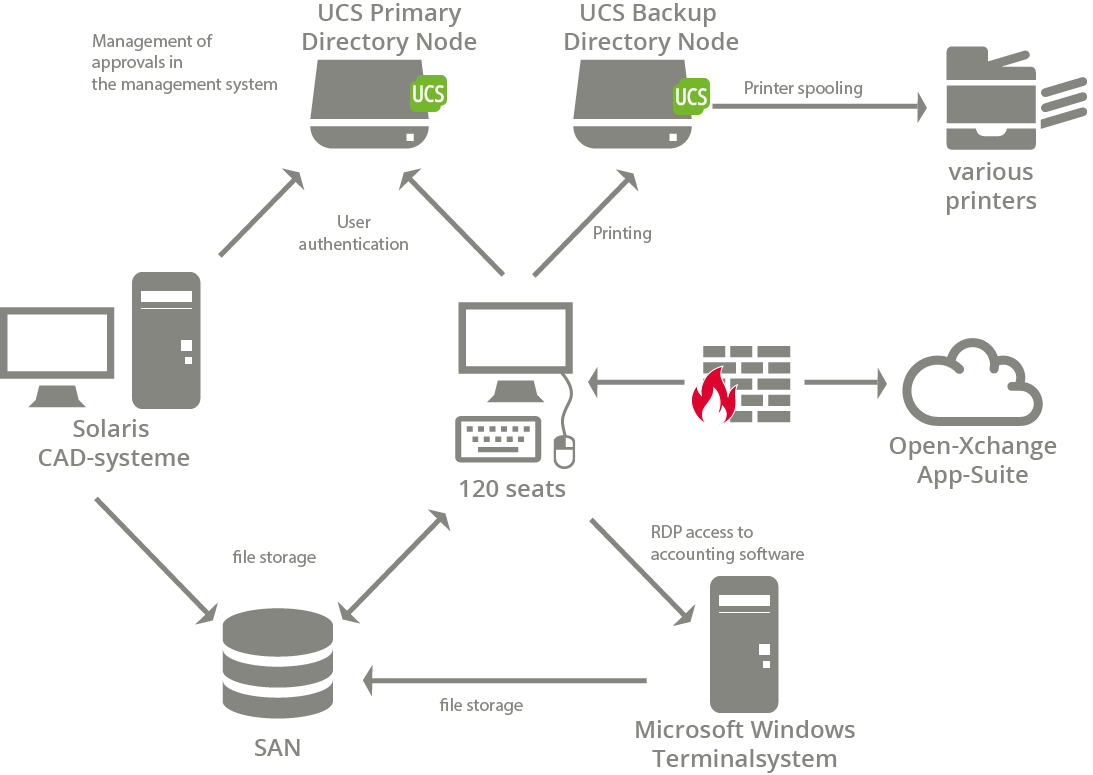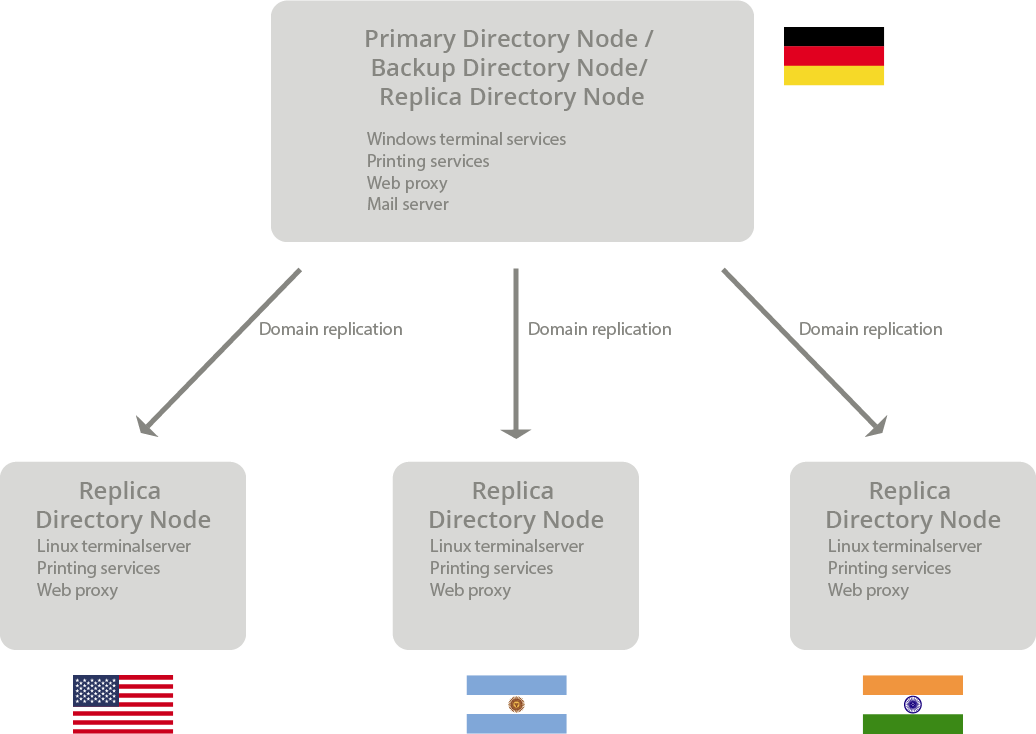2. Medium-sized mechanical engineering company#
Ganupa Technologies is one of the leading manufacturers of rolled steel mills. At the company headquarters in Germany, 260 people are employed in Production, Administration, Design and Sales. In addition, there are also local offices in the USA, Argentina and India, each with 5-10 employees.
Linux is predominantly used on the desktops. The employees from Design and Development are dependent on Linux software and require a freely configurable desktop.
The employees from Administration and Sales will only be offered an office suite, an email client and a web browser.
An accounting software required by some users is only available for Microsoft Windows. Part of the design process is performed with a CAD software, which is only available for Oracle Solaris.
The administration of the computers needs to be as central as possible. Whilst there are two IT technicians in the headquarters, there are no technical personnel at the other three branch offices.
To avoid non-productive times caused by malfunctions, the majority of the offered services must be provided redundantly.
A proxy server will buffer the network traffic in a cache and provide virus protection.
A groupware solution is required for the coordination of the globally distributed work procedures.
All user data is centrally saved on an Storage Area Network device (SAN).
2.1. Implementation#

Fig. 2.1 System overview of Ganupa Technologies headquarters (virtualization is not considered)#

Fig. 2.2 Global organization scheme of Ganupa Technologies#
2.2. Directory Nodes / LDAP directory#
The company implements an infrastructure composed of a UCS Primary Directory Node, a UCS Backup Directory Node, several UCS Replica Directory Nodes and desktop systems consisting of desktop computers and notebooks. Microsoft Windows and Ubuntu Linux are used on those systems.
The Primary Directory Node is the centerpiece of the UCS domain. The central, writable copy of the LDAP directory service is maintained on this system.
The Backup Directory Node largely represents a copy of the Primary Directory Node. In this way, the important services are available doubled on the network, the availability of the services is thus further increased and the load is distributed between the UCS Directory Nodes.
If the Primary Directory Node fails as a result of a hardware defect, the Backup Directory Node can be converted to the Primary Directory Node in a very short time.
The Primary Directory Node and Backup Directory Node are both installed at the company headquarters. The two UCS systems operate an LDAP server and provide login services for the domains. A DNS and DHCP server maintained with data from the LDAP directory runs on both systems and provides central IP management. A print server is set up on the Backup Directory Node.
2.3. Print services#
Print jobs are forwarded to the requested printer through a print server. The print servers are realized with CUPS, which manages the different printers in a central spooling.
In some larger offices several printers are grouped together into a printer group; the users simply print on this group, whereby the print jobs are equally distributed and the next free printer is used. This saves the users from having to check whether a particular printer is already in use.
2.4. Integration of Oracle Solaris systems#
A specialist application for CAD design is only available for Oracle Solaris. The name services on the Solaris system have been adapted to query the UCS LDAP for authentication. Users can sign in to the Solaris system with their domain user identification and password. This negates the need for the additional maintenance of local Solaris user accounts.
The Solaris system is assigned its IP address from the UCS DHCP servers through DHCP. The files are saved on the UCS file servers through a NFS share.
2.5. Data management#
All user data is stored on a central Storage Area Network (SAN) system. The different shares are registered and administrated in the Univention Management Console. The Linux and Solaris clients connect to individual shares through the network file system (NFS), the Windows clients through the CIFS protocol.
2.6. Groupware#
Ganupa Technologies uses the groupware solution Open-Xchange App Suite for arranging meetings and organizing contacts and tasks.
The groupware server is operated as a Replica Directory Node system on the Amazon EC2 cloud. This allows flexible scaling of the groupware system to growing performance and storage requirements. The installation can be performed with a few clicks using the App Center.
The administration of the groupware-related attributes integrates seamlessly in the Univention Management Console. The employees connect to the groupware through the OX App Suite web client and Mozilla Thunderbird.
Mobile devices like smartphones and tablets are integrated through the Microsoft ActiveSync protocol.
Virus detection including signature updates and spam filters are integrated at no additional cost.
2.7. Outlook#
At a later point in time, the plan is to monitor the internet traffic centrally through a web proxy. For this purpose, UCS provides the app Proxy server/ web cache (Squid).
Alternatively, it is also possible to procure a specialized appliance, which can authenticate the users against the UCS LDAP server.